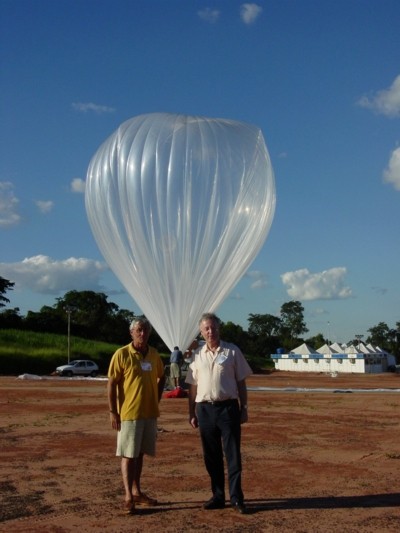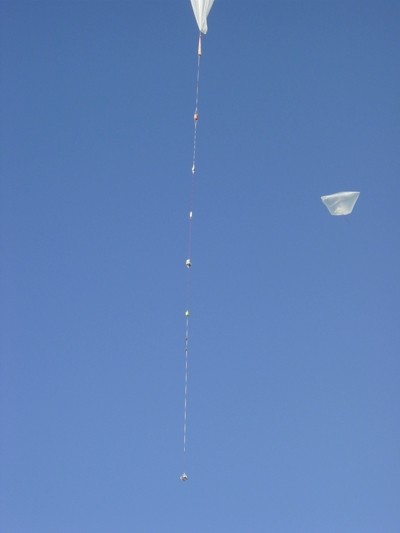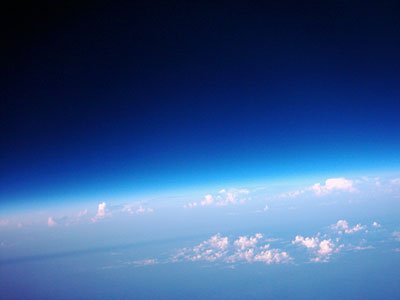Purpose of the flight and payload description
The SF series of multi-instrument balloon flights during HIBISCUS camapign were planned to be launched in late afternoon, and once reached float altitude left them to descend very slowly (0.5 meter per second or less) after their cooling at night for exploring the Tropical Tropopause Layer and the Upper Troposphere down to 12-14 km. The flight train was integrated by the following instruments:
DESCARTES stands for Détermination Et Séparation par Chromatographie lors de l'Analyse des Résultats des Traceurs Échantillonés dans la Stratosphère and was created for the measurement of long-lived trace gases (CFC-11, CFC-113, CCl4 and CH3CCl3) in the stratosphere by the University of Cambridge. The low weight of less than 20 kg and no need for telemetry make the instrument suitable for being launched on small balloons or fly as piggyback on larger balloons. The working principle is to let an amount of air pass through 16 sample tubes containing a Carboxen adsorbent. A valve allows only one tube at a time to be exposed to the air flow. Trace gases will then be trapped inside the sample tubes while the rest passes through. An on-board computer controls the sampling sequence, and also measures the flow of air, the pressure and temperature, the level of the batteries, and the state and position of the valve. After the flight, the data is downloaded from the computer, the sample sizes are determined and the sample box is connected to a gas chromatograph for quantification.
LABS is a backscatter diode laser developed by the Istituto di Scienze dell'Atmosfera e del Clima (CNR-ISAC) and Ente Nazionale per le Nuove tecnologie, l'Energia e l'Ambiente (ENEA). It provides an in-situ measurement of the aerosol volume backscatter coefficient and aerosol depolarization at 532 nm. The aerosol volume backscatter coefficient detects the presence of aerosols in the air mass sampled, as well as a rough estimation of their quantity. The aerosol depolarization, being the ratio to what extent the main polarization of the laser is preserved in the backscattering process, gives information on the shape of the particles, and in some cases a coarse estimation of their dimensions as well.
The AIRS electric field instrument developed by the Centre d'Etude des Environnements Terrestre et Planetaires was designed to measure the vertical component of the atmospheric electric field from DC to 10 kHz and the electric conductivity of the atmosphere through the relaxation technique. It uses the double probe technique with 2 carbon coated cylindrical electrodes, 3 cm in diameter and 15 cm long, installed at the ends of a vertical boom, 1 meter in length, located 25 cm away from the gondola. Grounded plates, also coated with carbon, are installed on the sides of the gondola. Data are recorded in 2 channels, one for large amplitude DC signals, and the second one for low amplitude AC signals.
µDIRAC which stands for Determination In situ by Rapid Analytical Chromatography was designed by the University of Cambridge to measure halocarbons in the atmosphere. It evolved from the original design of other instruments named DESCARTES and DIRAC to meet the need for more flexible, autonomous, low power halocarbon analysis. It was originally designed for use on Montgolfier Infra Rouge (MIR) long duration balloons. However, it has proven versatile and has also been used in aircraft and ground-based deployments. The instrument is a temperature programmed gas chromatograph with electron capture detector (GC-ECD) that measures a range of halocarbons (including short-lived tracers having biogenic and anthropogenic sources) with measurement precision relative standard deviations ranging from ± 1% (CCl4) to ± 9% (CH3I).
The Surface Acoustic Wave (SAW) H2O sensor is a frost point hygrometer developed by the University of Cambridge that uses a surface acoustic wave (SAW) crystal instead of the classic cooled mirror and optical detector. The SAW crystal is placed, together with an accurate platinum resistance thermometer, onto a Peltier cooler. When cooled to the frost point, water vapour condenses onto the SAW surface, reducing the SAW oscillation frequency and amplitude, forming the basis of a feedback circuit. The temperature at which condensation occurs is then related to the ambient water vapour amount.
The Solid State Ozone Sensor (SSS O3) developed by the University of Cambridge consists of a thin tungsten oxide layer mounted on a small ceramic tile. When is heated to its operating temperature, oxygen vacancies, formed thermally at the oxide surface, create electron donor states, resulting in an increase in charge carrier concentration. Ozone molecules react filling the oxygen vacancies, thus decreasing the charge carrier concentration. Measuring the change in electrical resistance, lead to infer in a few seconds the ozone concentration. Its weight is less than 0.5 kg, excluding batteries.
The lightweight Tunable Diode Laser (TDLAS) developed by the National Physical Laboratory (NPL) uses near-infrared tunable diode lasers and an astigmatic Herriott cell to measure spectroscopic absorption over a pathlength of up to 101 m. The instrument is used for fast response measurements of atmospheric tracers on board balloons and aircrafts. The instrument
was configured for water vapour measurements during HIBISCUS, using an all-metal gondola designed to minimise out-gassing. The measurements were made at a frequency of 0.7 Hz over three water vapour absorption lines.
Details of the balloon flight

Balloon launched on: 2/16/2004 at 18:25 local
Launch site: Meteorological Research Institute, Baurú, Sao Paulo, Brazil
Balloon launched by: Centre National d'Etudes Spatiales (CNES)
Balloon manufacturer/size/composition: Zero Pressure Balloon model 3SF (heavy payload and short duration) 3.000 m3
Flight identification number: SF-1
End of flight (L for landing time, W for last contact, otherwise termination time): 2/17/2004
Balloon flight duration (F: time at float only, otherwise total flight time in d:days / h:hours or m:minutes - ): 7 h 21 m
Landing site: Near the Parana state border, Brazil
Campaign: HIBISCUS
The SF1 mission was the second slow descent flight that was performed during the HIBISCUS campaign. The balloon was launched from Bauru, Brazil (22.36 S, 49.02 W) at 20:24 UT (17:24 local time) on 16th February 2004. The balloon reached an altitude of 20.5 km at sunset followed by a 6 hour very slow night time descent in a SW direction down to 15.8 km where it was cut down close to the border with Parana. In the map above we can see the development of the flight: in blue the ascent phase, in red the slow descent phase and in green from termination to landing.
The payload landed about 50 km west of Ourinhos, approximately 70 km from Bauru after a total flight time of 7 hours 21 minutes.
External references
- HIBISCUS campaign website at LATMOS website
- An overview of the HIBISCUS campaign Atmos. Chem. Phys., 11, 2309, 2011
- First airborne water vapor lidar measurements in the tropical upper troposphere and mid-latitudes lower stratosphere: accuracy evaluation and intercomparisons with other instruments Atmos. Chem. Phys., 8, 5245-5261, 2008
232If you consider this website interesting or useful, you can help me to keep it up and running with a small donation to cover the operational costs. Just the equivalent of the price of a cup of coffee helps a lot.




